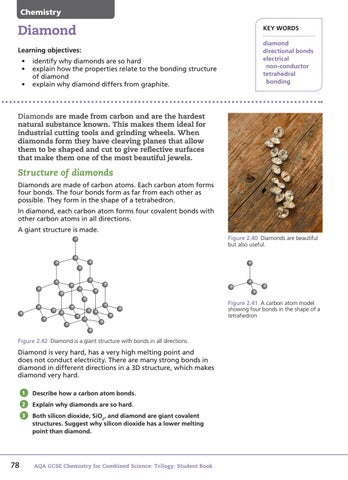Chemistry
Diamond Learning objectives: • identify why diamonds are so hard • explain how the properties relate to the bonding structure of diamond • explain why diamond differs from graphite.
KEY WORDS diamond directional bonds electrical non-conductor tetrahedral bonding
Diamonds are made from carbon and are the hardest natural substance known. This makes them ideal for industrial cutting tools and grinding wheels. When diamonds form they have cleaving planes that allow them to be shaped and cut to give reflective surfaces that make them one of the most beautiful jewels.
Structure of diamonds Diamonds are made of carbon atoms. Each carbon atom forms four bonds. The four bonds form as far from each other as possible. They form in the shape of a tetrahedron. In diamond, each carbon atom forms four covalent bonds with other carbon atoms in all directions. A giant structure is made. Figure 2.40 Diamonds are beautiful but also useful.
Figure 2.41 A carbon atom model showing four bonds in the shape of a tetrahedron
Figure 2.42 Diamond is a giant structure with bonds in all directions.
Diamond is very hard, has a very high melting point and does not conduct electricity. There are many strong bonds in diamond in different directions in a 3D structure, which makes diamond very hard.
78
1
Describe how a carbon atom bonds.
2
Explain why diamonds are so hard.
3
Both silicon dioxide, SiO2, and diamond are giant covalent structures. Suggest why silicon dioxide has a lower melting point than diamond.
AQA GCSE Chemistry for Combined Science: Trilogy: Student Book
75054_P054_091.indd 78
5/24/16 8:52 PM
